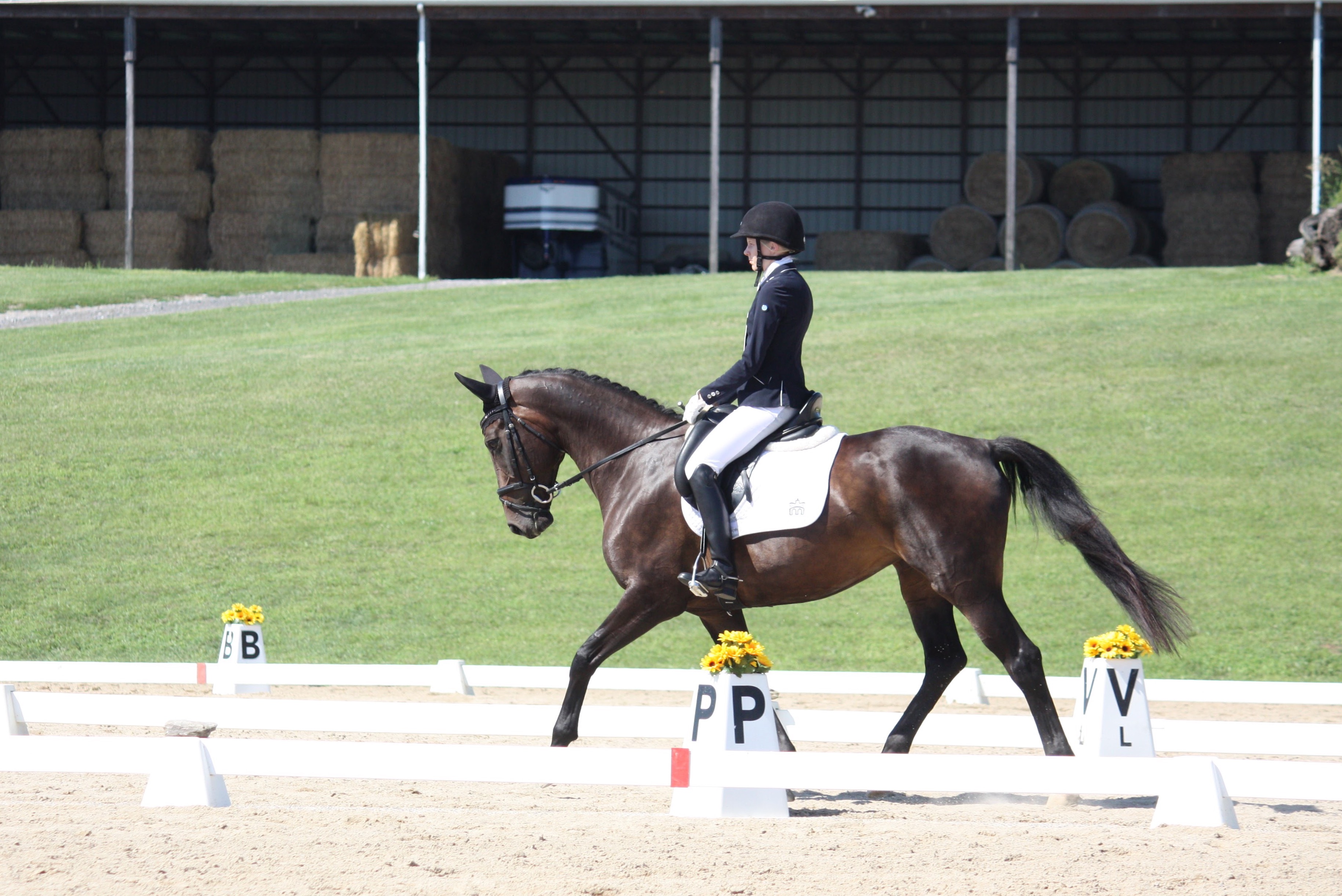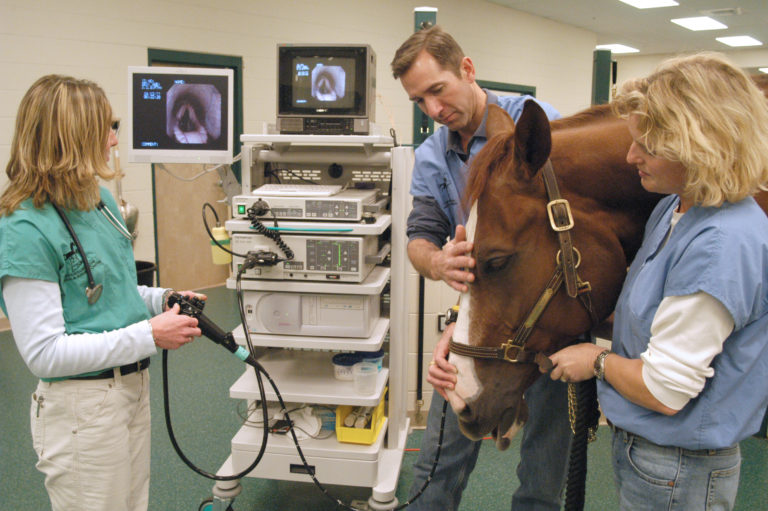
In this picture Vanessa Meeks is going around the arena just before entering the ring for a Second Level test. She is showing her own 8-year-old Dutch Warmblood/Rheinlander cross, Fiona Tetti.
The moment when you are riding around the outside of the arena before the judge rings the bell is often an opportunity for a final check and fine-tuning and is more important than we often think. I remember my own mare would change her sensitivity to a much more alert level, and the same aids I needed in the warm-up would have made her jump out of her skin in the arena. The moment around the arena was my last and only chance to tune into her and then she performed with utmost lightness and ease.
Vanessa and Fiona look very focused. They appear fit and ready for the task of a Second Level test. Fiona seems to be obedient and listening to her rider. I notice a slight tension in the mare’s body that is visible in the backline (right behind the saddle) and in the shortened stride of the hind leg. Fiona is trotting with her diagonal legs landing together. This allows me to measure the distance between her front legs and hind legs. Then it becomes obvious that she is striding longer with her front legs and shorter behind.
Vanessa is sitting nicely upright and seems to focus with high concentration on the task ahead of her. In her leg position, I notice that her foot is slightly turned out. This often is caused by slight tension in the hip joint. Her shoulders and upper-arm position are correct, but I can spot that her left wrist is a little over-bent and turned downward. This sometimes happens when a rider wants to control a situation too much by using the hand for just a fraction of a second, followed by giving the hand forward again. It is hard to judge whether this is just a bad moment for Vanessa’s hand or if this is truly a habit that needs to be addressed. In general, the reins are always the brakes for the horse’s hind legs and therefore for his engine. A restricting contact with the reins will consequently lead to restricted movement in the hind legs.
My first inclination when looking at this pair would be to tell Vanessa this: stretch up, put your hands forward, breathe out, relax your legs and ride the best you can! There is nothing you can repair in that final moment, therefore this is the time to build up all your confidence and pass it on to your horse. I sometimes hear riders complain about the difficulty of “holding it together” in a test. This is exactly the problem here. Rather than focus on holding it together, you need to focus on letting go, which is necessary to improve balance and gaits. Furthermore, entering Second Level with the beginning of collection requires more letting go. It requires more self-carriage of the horse, less control with the hands and more balance control in the rider’s seat.
I would recommend that Vanessa ride many downward transitions with the focus on a soft and forward-pushing rein until she can trust that the horse will listen to her seat and does not need the control of her hands. Then she can remind herself and Fiona of this balance just before entering the arena and will be able to ride with a more forward and uphill collection. But remember, forward does not mean fast.
I also analyzed Vanessa on a different horse in 2013, and I would like to refer to a task I gave her back then. I had proposed riding transitions between a jumping position and a dressage position to get her upper body more balanced so that she needs less help from her lower leg to maintain her upper-body balance. To achieve this, I would again recommend the forward seat for her, but now not only in the jumping position but also in a posting position with an upright upper body. This will help her ground her legs and improve her feel in the stirrups. Now, keep that longer-leg feeling in mind as you try this: Sit on a chair with your feet parallel to each other and in front of you. Start by lifting one knee as high as you can while the ball of your foot and your toes are still on the ground. Then start alternating rhythmically between your knees. In this task, it becomes obvious that the knee is a connecting middle joint and every move of the knee creates movement in your hips and ankles. This should show you the connection between your hip and ankle. Putting your heel down means opening and extending in your hip joint. When your heel is up, you are flexing your hip joint. If your ankle is not moving, that means your hip joint is locked and tight, too.
You can apply this same concept on your horse. Try it first at the walk. Now your legs are not on solid ground but are supported by a moving stirrup. Your goal will be to be able to move your knees slightly up and down without changing the contact on the stirrup or the position of the stirrup. This is only possible with a supple hip and a mobile ankle. The next step is to continue this in trot. This is a bigger version of a supple leg, and when later minimizing this movement one can feel how the inside calf muscle can caress the horse lightly up and down on her side and, by that, encourage the activity of the hind leg.
These tasks need some time and practice at home but when mastered they can help to relax the seat just before a performance and competition. And to shine in dressage, suppleness is more important than strength and control. I wish Vanessa good luck with her future on her elegant and promising mount.
Susanne von Dietze is a leader in equestrian biomechanics. A physiotherapist, licensed Trainer A instructor and judge for dressage and show jumping, she gives lectures and seminars throughout the world, including at the prestigious German Riding Academy in Warendorf. She is a native of Germany and now lives with her husband and three children in Israel, where she competes at the international level. She is the author of two books on the biomechanics of riding: Balance in Movement and Rider and Horse, Back to Back. Find her books at www.EquineNetworkStore.com.











